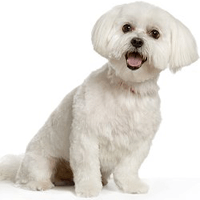
Major concerns: None
Life span: 12 – 14 years
Minor concerns: Patellar luxation, open fontanel, hypoglycemia, hydrocephalus, distichiasis, entropion
Avg Size of Male: Height: 9-10 inches, Weight: 4-7 pounds
Occasionally seen: Deafness, white shaker-dog syndrome
Avg Size of Female: Height: 9-10 inches, Weight: 4-7 pounds
Suggested tests: Knee, eye
Brief History on Maltese Breed Origin
Crusaders who were returning from the Mediterranean in the 14th century are the ones who brought this lively little dog to England. It quickly became an accessory for every upper class woman. They often carried their Maltese around in their sleeve, and even let them sleep in the bedroom with them. Even though it was a very popular dog at that time, its numbers were quite limited. It got to the point where the breed had been in danger of extinction. When this breed first arrived in England, it was often called the “Maltese Terrier,” although the breed is not a terrier. The Maltese first made its appearance in America in 1877, and the AKC recognized it a bit later down the line in 1888.
Maltese Breed Appearance
The Maltese is small and compact breed, known for its long, silky hair. It features pendant ears, and eyes that offer a gentle expression. This is a lively and active breed, which has a gait best described as free and lightweight. This breed only has a single layered coat. The coloring is generally pure white, although a light ivory color or slight yellow markings on the ears are acceptable.
Maltese Breed Temperament
It is gentle, loyal, and well behaved, making for the perfect lap dog and companion. It is also quite playful and bold, often taking on dogs much larger than it. It can be aloof with unfamiliar faces, and is known to bark at strange noises. Some Maltese will bark excessively at times, also if it is pampered too much it may develop jealous or aggressive behaviors towards strangers. The Maltese doesn’t do really well with children and other animals that are prone to roughhousing. It is a smart breed, but is can be quite hard to housebreak. The breed learns best when it knows it has a tasty reward waiting for them. This dog loves to play outdoors, and also loves getting dirty. It may require more bathing than most dogs because of it.
Maltese Breed Maintenance
The coat of the Maltese can become matted or tangled relatively easily, especially when wet. Carefully brush the coat regularly. Unlike other breeds, we recommend that you bath your Maltese regularly. Be sure that the coat is dried thoroughly and the dog is kept warm after bath time. Rinse and clean off the fur around the eyes, ears and feet. These areas are prone to staining. The extensive grooming maintenance make many owners opt to clip the coat, although this takes away from the breed’s most recognized traits. This little dog has minimal exercise requirements that can be met with indoor play, however the Maltese enjoys being outdoors as well. It makes an excellent choice for an apartment pet, because it is an active breed indoors. Although excessive barking may become a problem for neighboring families.
 Toledo, United States.
Toledo, United States.